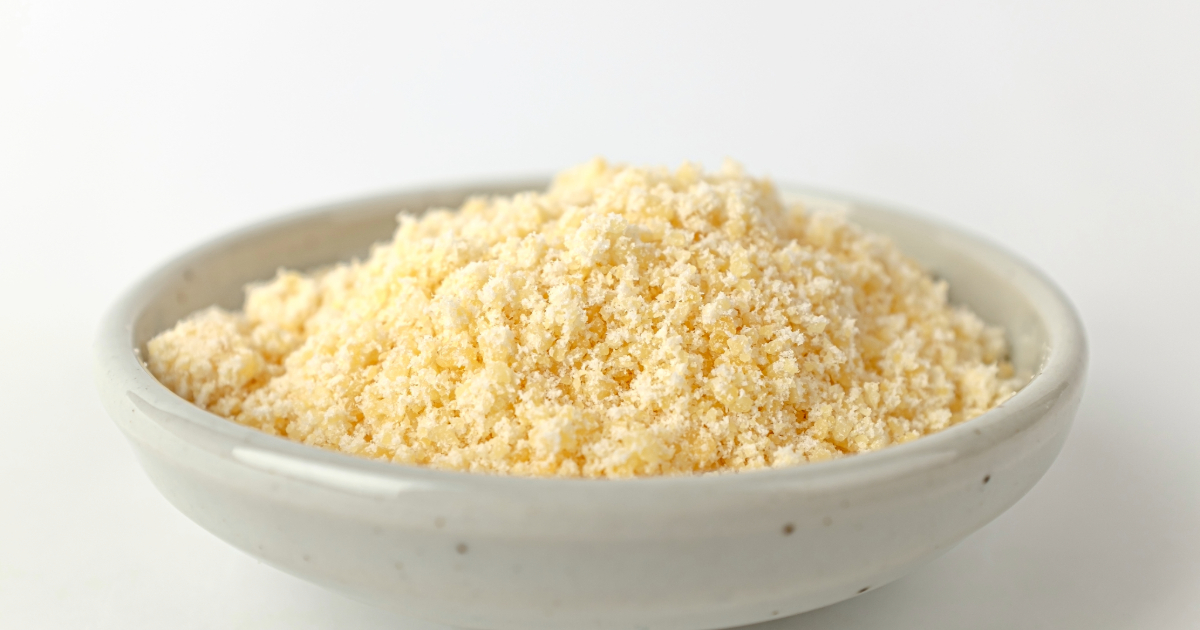Cheese powder is used to add cheesy flavor to dishes like macaroni and cheese, popcorn, potatoes, sauces, dressings, and more.

But what if you don't have cheese powder on hand or want an alternative? Thankfully, there are several options you can use instead.
Recreating the Cheesy White Cheddar Flavor
If you're trying to recreate the creamy white cheddar flavor of a brand like Annie's, you have a few good options. King Arthur Baking's white cheddar cheese powder is very popular and tastes quite similar. There's also a less expensive store-bought white cheddar powder that works well for mac and cheese or popcorn when combined with butter and milk.
You can also make your own white cheese sauce by melting white cheddar into a creamy béchamel sauce made from butter, flour, and milk. Adding white American cheese gives even more of that smooth, melty texture thanks to its emulsifying salts. And a bit of mozzarella makes things extra gooey.
Key Takeaway: For a specific white cheddar flavor, try King Arthur's powder, store-bought powders, melting white cheddar into béchamel, or adding white American cheese.
Cheese Replacements from Your Pantry
Don't have any cheese powders or blocks of cheddar on hand? No problem! You likely have some suitable substitutes already in your pantry.
Mac and Cheese Packets
The powdered cheese packets that come in boxes of Kraft or other macaroni and cheese mixes make an easy substitution. They provide that bright yellow, cheesy flavor in the right quantity. The only downside is they also contain starch and emulsifiers that could make popcorn or other foods gummy.
Nutritional Yeast
Nutritional yeast flakes lend a savory, cheesy umami flavor. Their taste works well sprinkled on popcorn or combined with ingredients like Parmesan. Just avoid using too much yeast, as it can create a strong flavor. Powdering the flakes first helps them incorporate better too.
Grated Parmesan
Grated Parmesan cheese or other hard Italian cheese can mimic some of that salty, sharp cheddar taste. Mix it with nutritional yeast flakes to round out the flavor.
Butter Powder
Buttery butter powders make a good base flavor, while additions like brewer's yeast or Parmesan fill in for the cheesy notes. The butter adds richness and combines well with the other ingredients.
Low-Carb Cheese Crisps
Crunchy low-carb cheese crisps like Whisps provide bold cheese flavor when powdered in a blender or food processor. Different varieties like cheddar and Parmesan allow customization too.
Key Takeaway: Raid your pantry for cheese packets, nutritional yeast, Parmesan, butter powder, and low-carb crisps when you lack cheese powder.
Producing Your Own Cheese Powder
You can also make DIY cheese powder at home through dehydration. Here are some methods to try:
Dehydrate Shredded Cheese
The simplest route is shredding blocks of cheddar, Parmesan, Swiss, or other favorite cheese then dehydrating the shreds. Spread them thinly on dehydrator trays or baking sheets and dry at 115° F until completely desiccated. Then blitz the crispy shreds into powder using a blender or spice grinder. Store in an airtight container.
Boil Down Grated Cheese
Grate softer cheeses like mozzarella or Monterey Jack, then gently boil the shreds in milk or water to drive off moisture. Drain in a cheesecloth-lined strainer and press out more liquid. Transfer the moist shreds onto parchment paper and continue drying in an oven on the lowest setting with the door propped open. Check frequently to avoid burning. Once dry, blend into powder.
Microwave Finely Shredded Cheese
For fast DIY powder, use a fine Microplane grater to shred semi-soft cheeses like cheddar, Havarti, or Swiss. Spread the wispy shreds in a thin layer on a microwave-safe plate. Microwave in 30-second intervals, stirring after each, until completely dehydrated. Let cool fully before powdering in a small blender or spice grinder.
Key Takeaway: Air-dry, boil, or microwave your favorite grated/shredded cheeses to create homemade versions of powdered cheese.
FAQs
What cheese varieties work best for powdering?
Harder cheeses like Parmesan and cheddar powderize nicely. Very soft cheeses may melt before fully drying. Aim for firmer textures.
Should I use raw or pasteurized milk cheeses?
Since powders receive extended heating/drying, raw milk cheeses pose no safety risk once desiccated. Use your preferred variety.
What consistency should finished cheese powder have?
Similar to cornstarch or flour. Too moist and it may clump. Overly dried and it loses flavor, so exercise care not to overdo it.
How should I store DIY cheese powder?
In a sealed glass jar kept in the pantry, away from light, heat, and moisture. For maximum freshness, store in fridge or freezer.
Can I use other dairy products like powdered buttermilk or butter?
Yes, options like butter powder, buttermilk powder, and dry milk solids make useful additions or substitutions.
What about anti-caking agents?
If clumping occurs, stir in a tiny amount of powdered cellulose, cornstarch, rice starch, or arrowroot using a ratio of 1 teaspoon per cup of powder.
Conclusion
With a bit of creativity and experimentation, lack of cheese powder doesn't have to halt your cooking endeavors.
Rely on handy pantry ingredients, whip up homemade powder, or use alternate forms of cheese.

